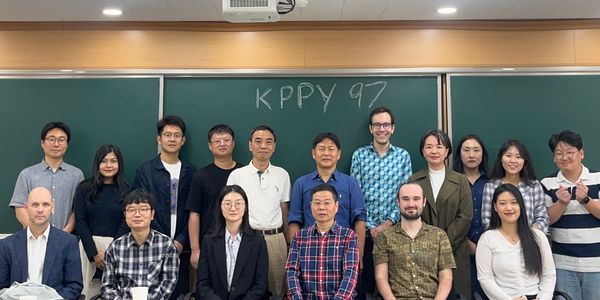KPPY 90
Greg Markowsky, Akihide Hanaki, Mark Siggers, Ilia Ponomarenko, Dong Yeap Kang

Nov 03, 2018. 11am - 5:30pm at KNU
| Schedule | ||
| 11:00am - 11:50 |
Greg Markowsky Monash University, Australia | The Cheeger constant for distance regular graphs |
| 12pm - 1:25 | Lunch | |
| 1:30 - 2:20 |
Akihide Hanaki Shinshu University, Japan | Double centralizers of association schemes |
| 2:30 - 3:20 |
Mark Siggers KNU | The Abel Prize |
| 3:30 - 4:20 |
Ilia Ponomarenko St. Petersburg Department of V.A. Steklov Mathematical Institute | Two-valenced association schemes and the Desargues theorem |
| 4:30 - 5:20 |
Dong Yeap Kang KAIST | On the rational Turán exponents conjecture |
Abstracts
Greg Markowsky
The Cheeger constant for distance regular graphs
The Cheeger constant for distance regular graphs
The Cheeger constant of a graph is the smallest possible ratio between the size of a subgraph and the size of its boundary. It is well known that this constant must be at least $\lambda_1/2$ , where $\lambda_1$ is the smallest positive eigenvalue of the Laplacian matrix.
In this talk I will discuss the conjecture that for distance-regular graphs the Cheeger constant is at most $\lambda_1$. The conjecture has been proved for most of the known infinite families of distance-regular graphs, for distance-regular graphs of diameter 2 (the strongly regular graphs), for several classes of distance-regular graphs of diameter 3, and for most distance-regular graphs with small valency. A number of cases remain open.
This is joint work with Jacobus Koolen and Zhi Qiao.
In this talk I will discuss the conjecture that for distance-regular graphs the Cheeger constant is at most $\lambda_1$. The conjecture has been proved for most of the known infinite families of distance-regular graphs, for distance-regular graphs of diameter 2 (the strongly regular graphs), for several classes of distance-regular graphs of diameter 3, and for most distance-regular graphs with small valency. A number of cases remain open.
This is joint work with Jacobus Koolen and Zhi Qiao.
Akihide Hanaki
Double centralizers of association schemes
Double centralizers of association schemes
For an association scheme $(X,S)$ and an arbitrary field $F$, we can
define the adjacency algebra $FS$ of the association scheme over the
field as a subalgebra of the full matrix algebra. Thus we can consider
double centralizer $C^2(FS)$ of the adjacency algebra in the full matrix
algebra. In general, $FS \ne C^2(FS)$, however $FS=C^2(FS)$ holds for a
schurian scheme. In this talk, we will show that if $|S|\leq 3$, then
$FS=C^2(FS)$ and give an example such that $FS \ne C^2(FS)$ and $|S|=4$.
Mark Siggers
The Abel Prize
The Abel Prize
We give a talk about the Abel Prize: how it came to be, how it works, who has won it, and who will win it next. This talk is a talk I accidently volunteered to give at my university, extended slightly by the inclusion of some challenging jokes.
Ilia Ponomarenko
Two-valenced association schemes and the Desargues theorem
Two-valenced association schemes and the Desargues theorem
The main goal of the talk is to establish a sufficient condition for a two-valenced association scheme to be schurian and separable. To this end, an analog of the Desargues theorem is introduced for a non-commutative geometry defined by the scheme in question. It turns out that if the geometry has enough Desarguesian configurations, then under a technical condition the scheme is schurian and separable. This result enables us to give short proofs for known statements on the schurity and separability of quasi-thin and pseudocyclic schemes. Moreover, by the same technique we prove a new result: given a prime p, any meta-thin {1,p}-scheme with thin residue isomorphic to an elementary abelian p-group of rank greater than two, is schurian and separable.
This is joint with M.Hirasaka and K.Kim.
This is joint with M.Hirasaka and K.Kim.
Dong Yeap Kang
On the rational Turán exponents conjecture
On the rational Turán exponents conjecture
The extremal number $ex(n,F)$ of a graph $F$ is the maximum number of edges in an $n$-vertex graph not containing $F$ as a subgraph. A real number $r \in [1,2]$ is realisable if there exists a graph $F$ with $ex(n , F) = \Theta(n^r)$. Several decades ago, Erdős and Simonovits conjectured that every rational number in $[1,2]$ is realisable. Despite decades of effort, the only known realisable numbers are $1, 7/5, 2$, and the numbers of the form $1+(1/m), 2-(1/m),$ and $2-(2/m)$ for integers $m\geq1$. In particular, it is not even known whether the set of all realisable numbers contains a single limit point other than two numbers 1 and 2.
We discuss some recent progress on the conjecture of Erdős and Simonovits. First, we show that $2-(a/b)$ is realisable for any integers $a,b \geq 1$ with $b>a$ and $b\equiv\pm1$ (mod a). This includes all previously known ones, and gives infinitely many limit points $2-(1/m)$ in the set of all realisable numbers as a consequence. Secondly, we propose a conjecture on subdivisions of bipartite graphs. Apart from being interesting on its own, we show that, somewhat surprisingly, this subdivision conjecture in fact implies that every rational number between 1 and 2 is realisable.
This is joint work with Jaehoon Kim and Hong Liu.
We discuss some recent progress on the conjecture of Erdős and Simonovits. First, we show that $2-(a/b)$ is realisable for any integers $a,b \geq 1$ with $b>a$ and $b\equiv\pm1$ (mod a). This includes all previously known ones, and gives infinitely many limit points $2-(1/m)$ in the set of all realisable numbers as a consequence. Secondly, we propose a conjecture on subdivisions of bipartite graphs. Apart from being interesting on its own, we show that, somewhat surprisingly, this subdivision conjecture in fact implies that every rational number between 1 and 2 is realisable.
This is joint work with Jaehoon Kim and Hong Liu.




